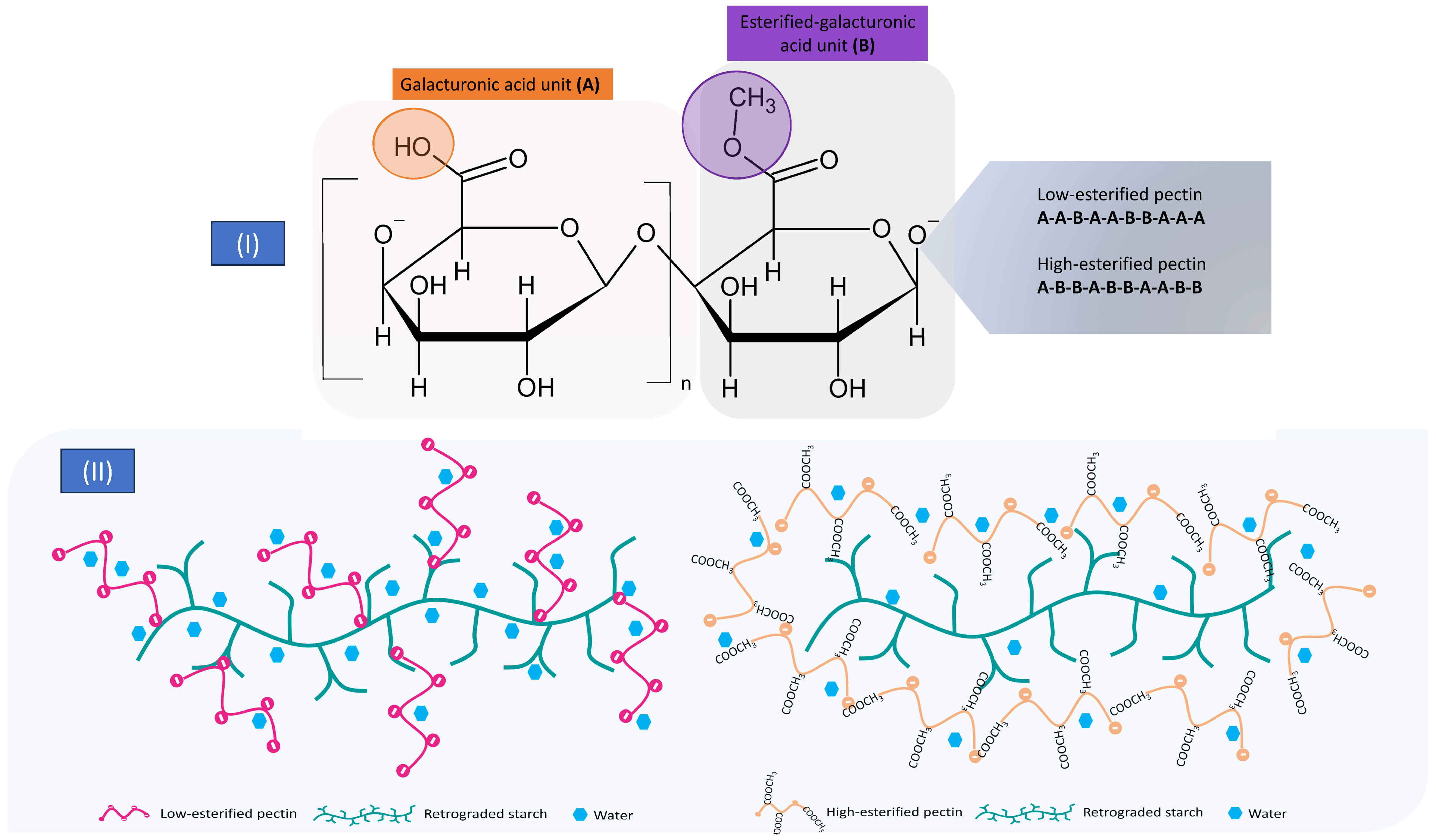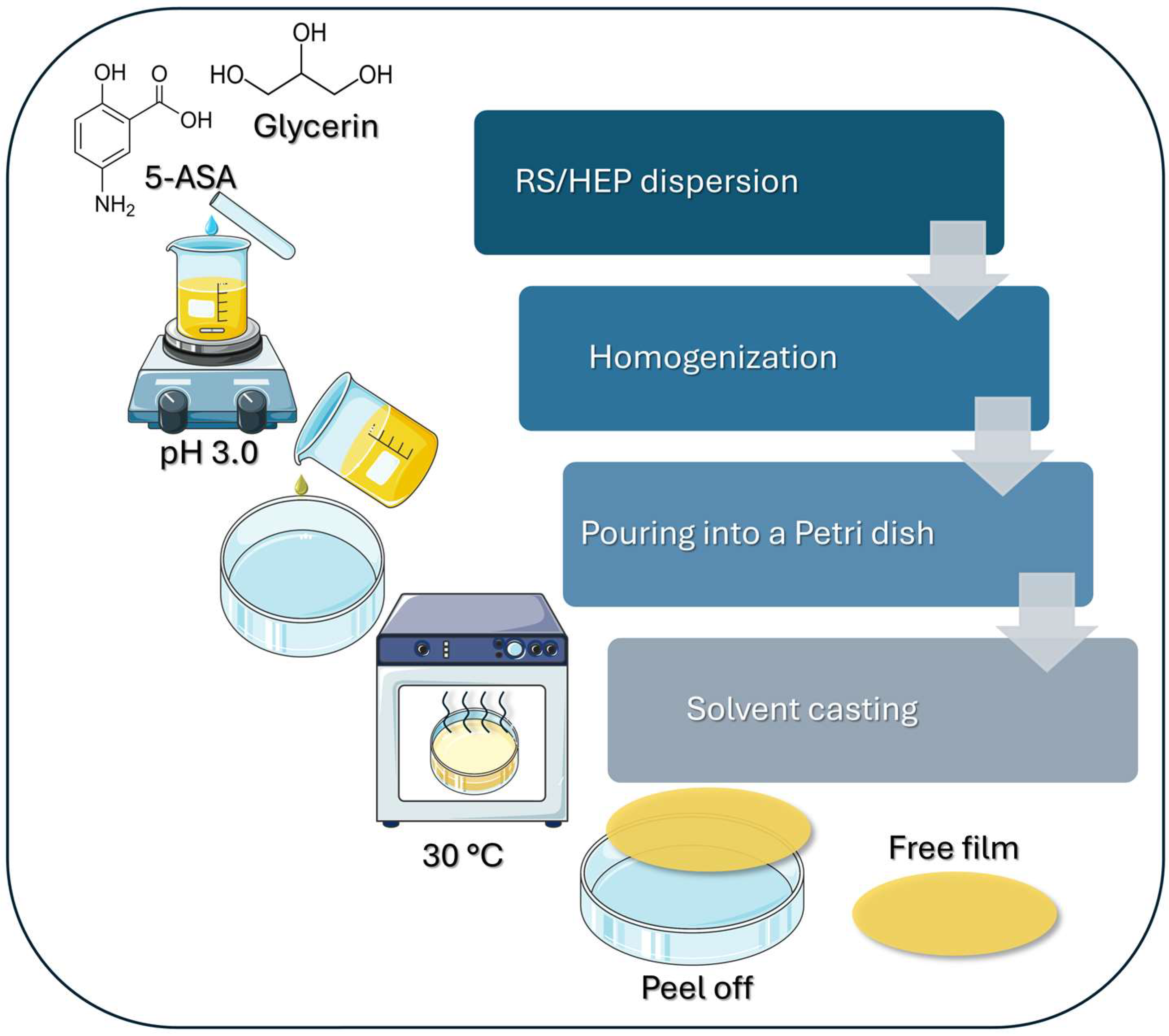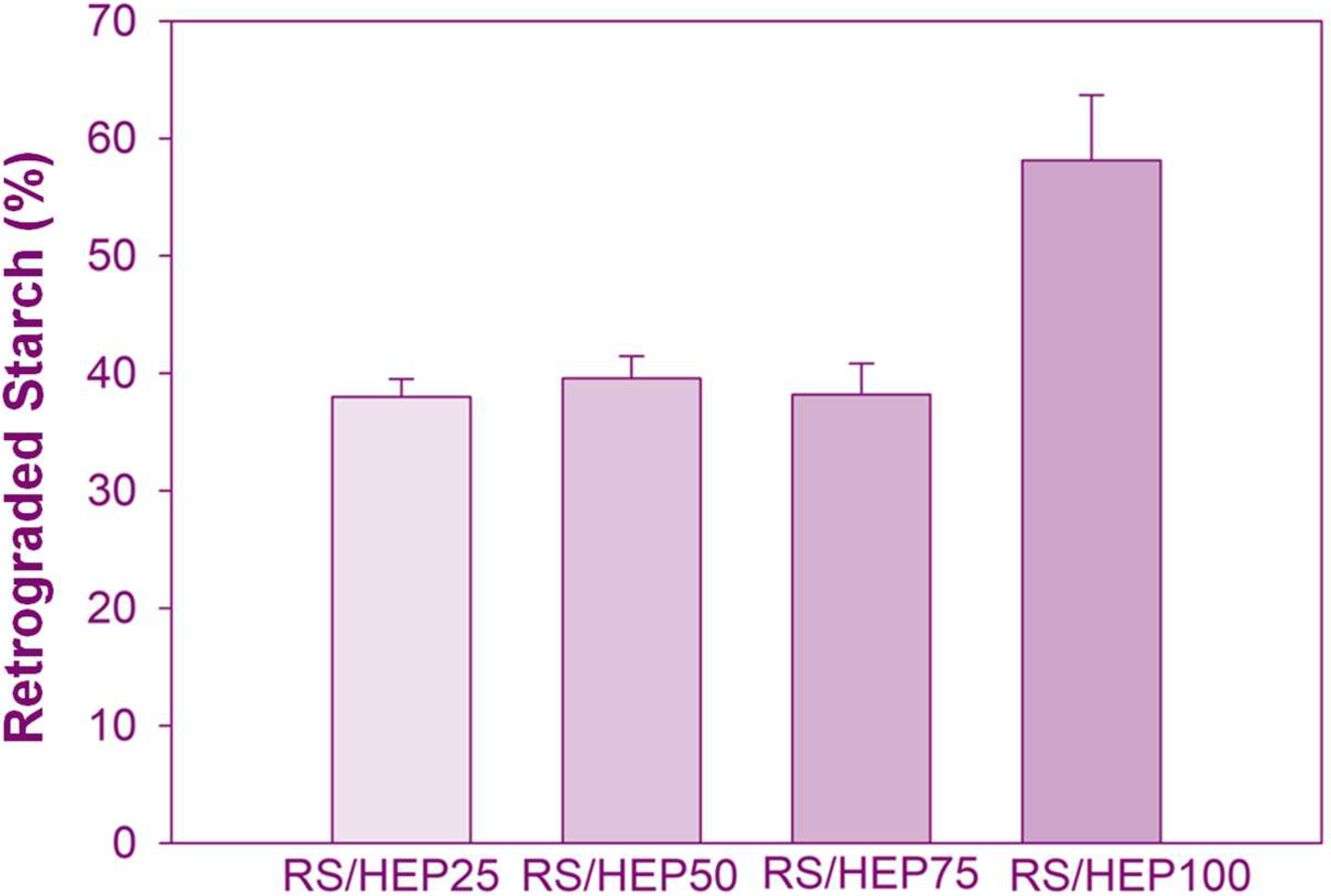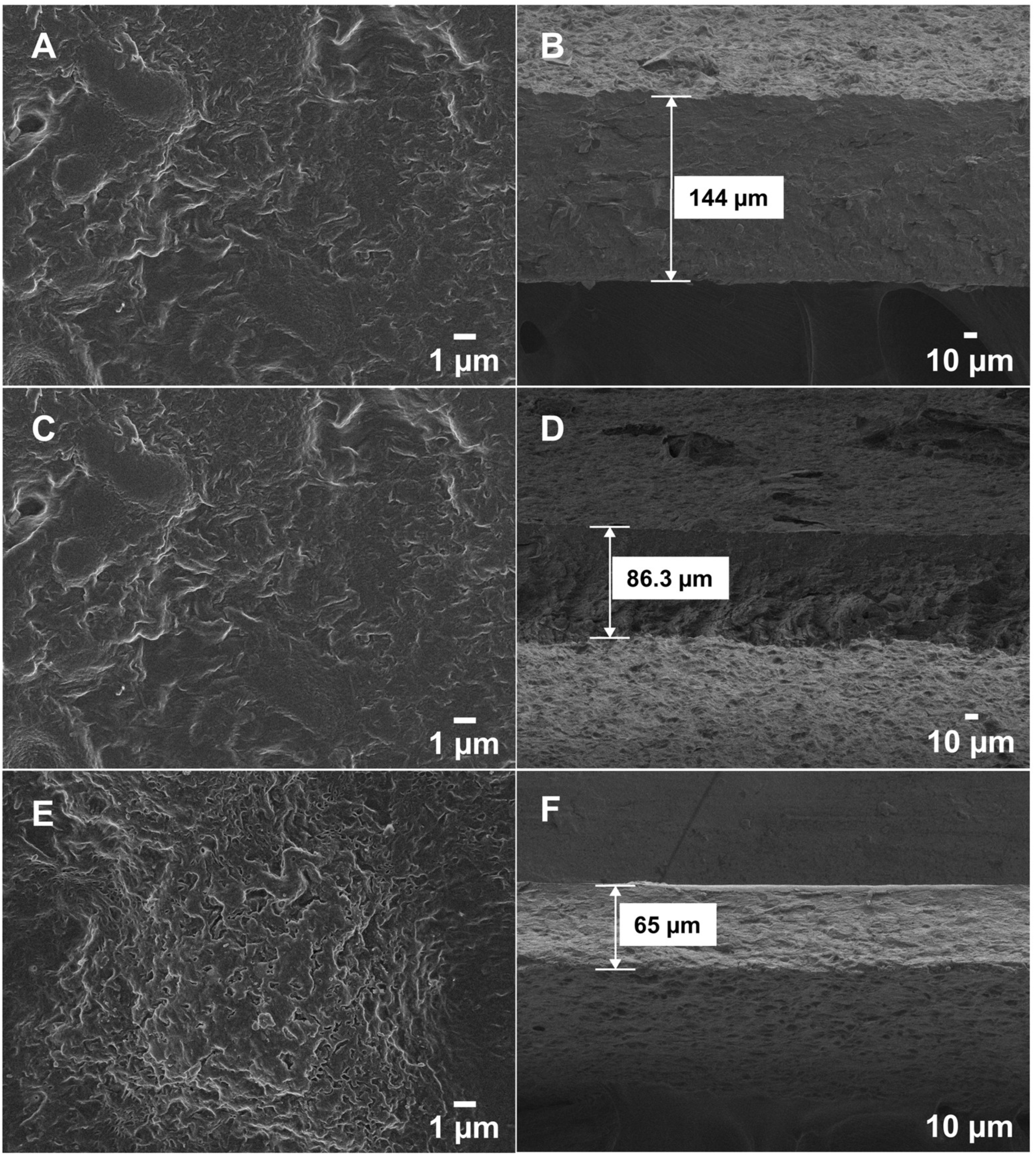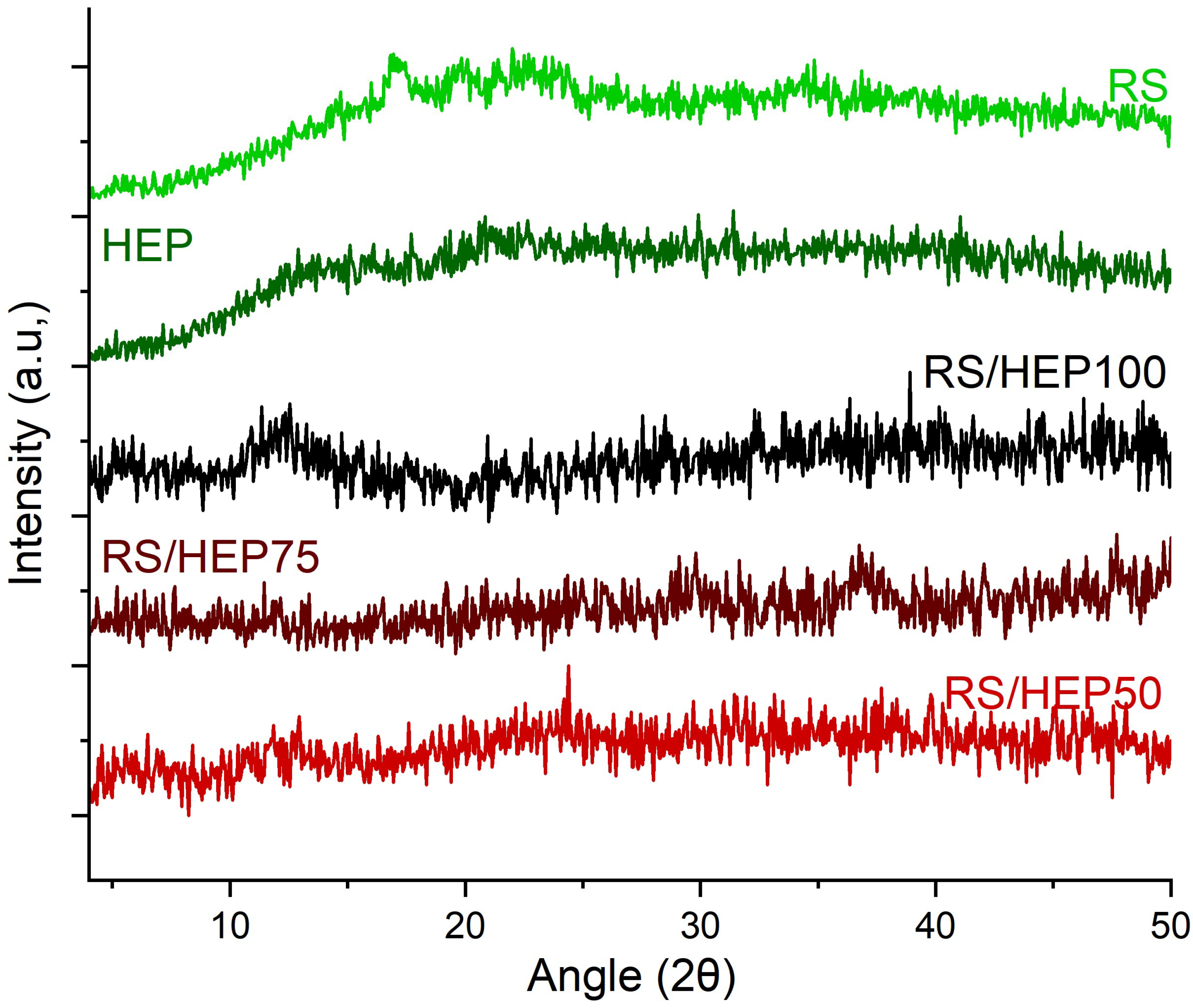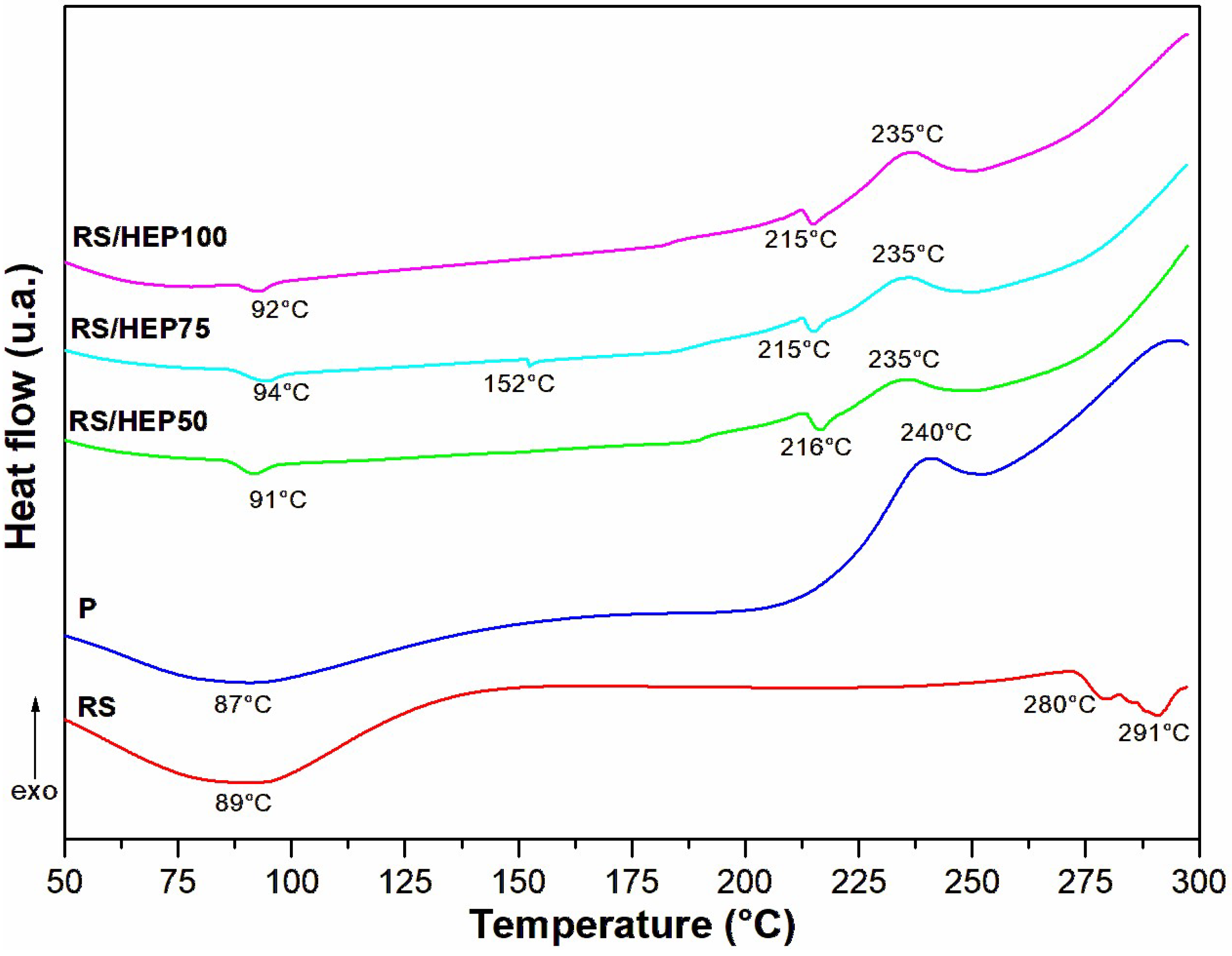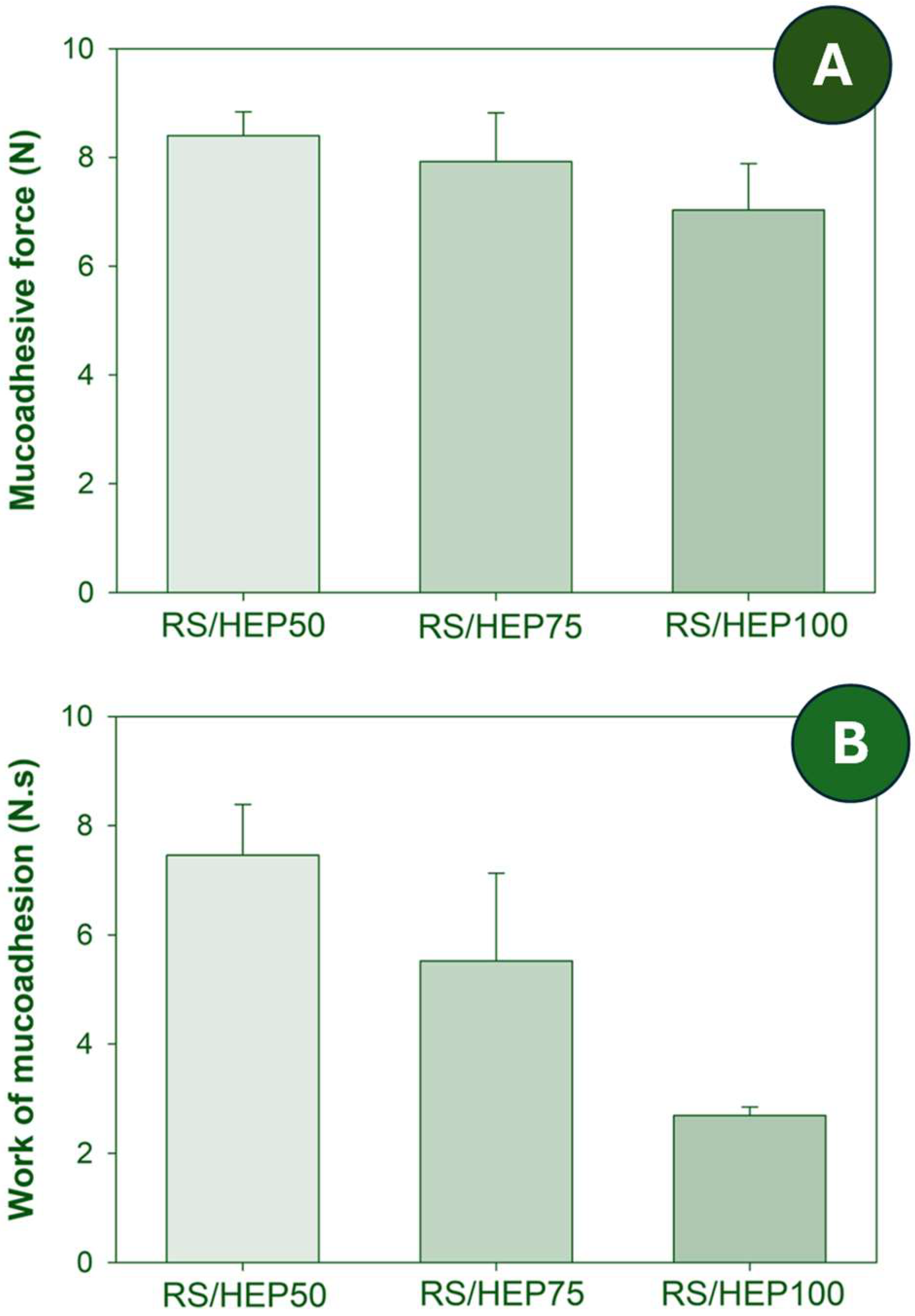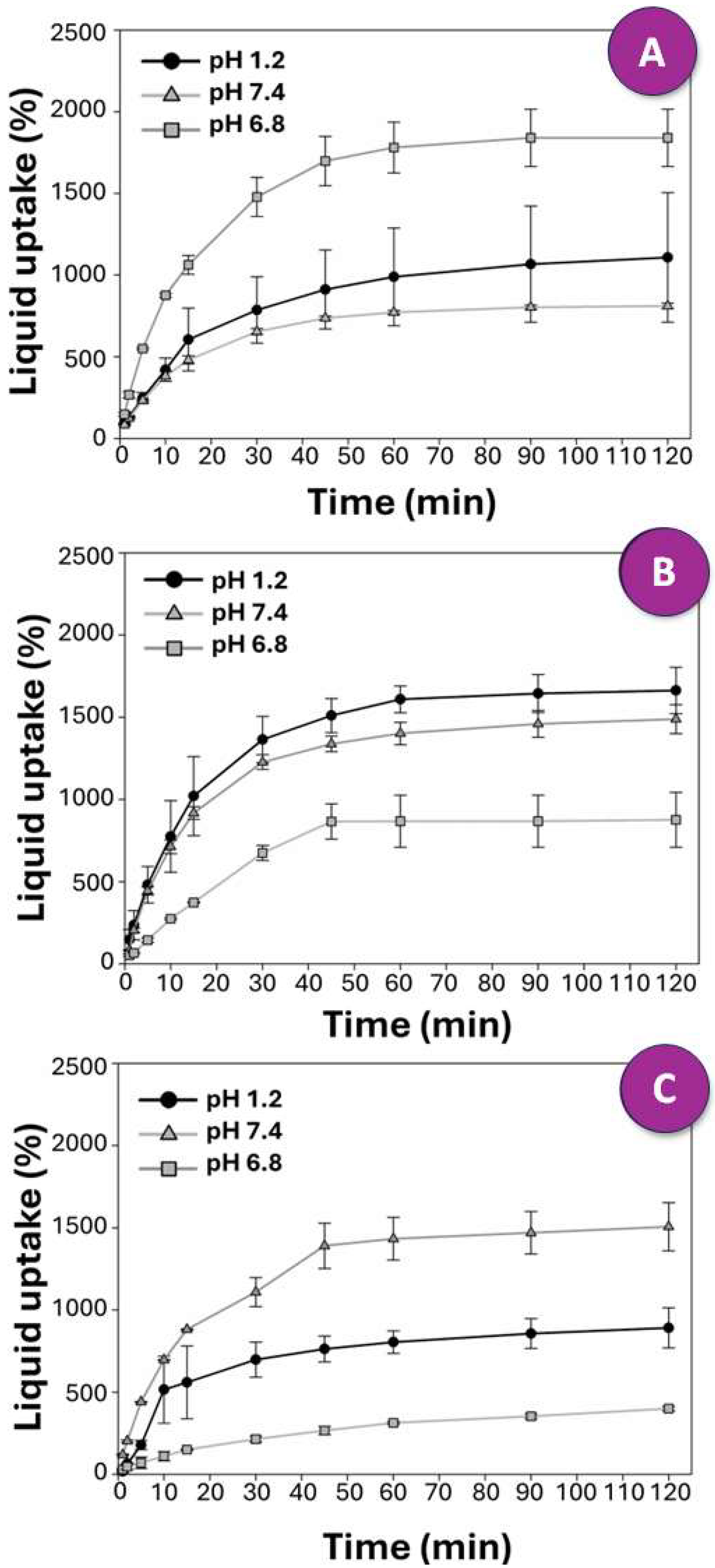1. Introduction
The therapeutic management of inflammatory bowel disease (IBD) depends critically on the ability to deliver drugs selectively to inflamed colonic regions [
1]. Despite the availability of several oral formulations, premature release in the upper gastrointestinal tract and poor site-specificity remain common limitations [
2]. Mesalazine (5-aminosalicylic acid), a first-line agent in IBD, requires local action in the colon to exert its anti-inflammatory effects with minimal systemic exposure [
3,
4]. This clinical need has driven efforts toward the development of biodegradable materials capable of achieving controlled release profiles aligned with the pathophysiology of the distal intestine [
5].
Coating solid pharmaceutical dosage forms with biodegradable polymers is a well-established strategy for achieving colon-specific drug delivery [
6]. This tool is particularly advantageous, as the enzymatic activity unique to the colonic environment provides a more reliable targeting mechanism than pH- or transit time-dependent systems, which are subject to considerable inter- and intra-individual variability [
7]. Within this context, polymeric films have emerged as a versatile and effective platform, offering benefits such as ease of administration, improved patient adherence, and controlled release kinetics [
8]. Among them, RS-based films stand out due to their low water solubility, high thermal stability, and selective enzymatic degradation in the colon [
9]. Furthermore, systems based on natural polysaccharides from renewable sources, such as RS/HEP films, offer advantages like solvent-free processing and eco-friendly production under mild conditions.
RS, obtained by gelatinizing HAS followed by controlled cooling and storage, forms semi-crystalline structures that resist enzymatic digestion in the upper gastrointestinal tract and offer unique structural–functional advantages as a biomaterial [
10]. These domains confer structural stability and delay degradation, creating an opportunity to exploit RS as a protective matrix in site-directed oral delivery systems [
11]. In this context, film-based formulations enable close contact with the mucosal surface, promoting localized release and extended residence time, an advantage in IBD, which is often marked by disrupted mucosal integrity and episodes of accelerated transit (diarrhea) [
12]. Compared to conventional coated dosage forms, mucoadhesive films offer improved drug retention and reduced sensitivity to gastrointestinal transit variability [
13,
14].
The integration of pectin into RS-based films provides a strategic means to modulate polymer network architecture, with its physicochemical behavior critically influenced by the degree of esterification (DE) (
Scheme 1) [
15]. In a pioneering study by our research group, coating films composed of RS and low-esterified pectin (LEP) were successfully developed [
9]. The films displayed favorable mechanical properties, with puncture strength ranging from 8.9 to 29.3 MPa and elongation at break between 0.9 and 1.1%. They exhibited pH-dependent swelling in gastrointestinal media and improved barrier performance, as indicated by water vapor permeability values of 0.91–5.46 × 10
−4 g·mm·m
−2·h
−1·Pa
−1. Additionally, their high RS content (65.80–96.69%) conferred enzymatic resistance in the upper gastrointestinal tract and reduced dissolution under acidic conditions, supporting their potential for colon-targeted drug delivery.
Since then, the RS/LEP blend has been employed in the development of various drug delivery systems, including hydrogels [
16], free-standing films [
17], matrix tablets [
18], ionotropically gelled microparticles [
19], polymeric nanoparticles [
20], nanoparticle-in-microparticle systems, and spray-dried microparticles [
21,
22]. As a proof of concept, Meneguin et al. [
23] applied the RS/LEP coating on gellan gum microparticles for oral insulin (INS) administration. This system demonstrated significant protection of INS against enzymatic degradation in the upper gastrointestinal tract, and improved intestinal permeability, representing a noteworthy advancement in oral peptide administration. However, the study revealed that approximately 32% of INS was released in the gastric environment, indicating that further optimization is needed to achieve more precise colon-targeted release.
To overcome this limitation associated with high aqueous solubility and swelling capacity of LEP, which may lead to premature drug diffusion, an alternative strategy involves replacing LEP (DE < 50%) with high-esterified pectin (HEP, DE > 50%) [
24]. HEP exhibits reduced aqueous solubility, limited ionization, and a propensity to form cohesive, low-permeability matrices, thereby enhancing structural integrity and enabling a shift toward enzymatically driven release aligned with colonic physiology [
25,
26]. Despite its favorable physicochemical attributes, the influence of HEP on the supramolecular organization of RS matrices and its downstream impact on drug diffusivity, permeability, and film cohesion remains poorly characterized [
27]. Elucidating how HEP alters the interplay between polymer chain mobility, matrix densification, and enzymatic susceptibility could inform the rational design of pH-independent delivery systems that rely on intrinsic material architecture rather than synthetic coatings for selective colonic targeting [
28].
This study addresses this gap by evaluating the functional impact of HEP on the development of RS-based polymeric films for the delivery of mesalazine. Focusing on the physicochemical consequences of varying HEP ratios, we assess the resulting changes in starch retrogradation, film morphology, mechanical performance, mucoadhesiveness, fluid interaction, and release dynamics. In doing so, we seek to establish HEP not simply as a formulation component, but as a determinant of structural organization and release control in advanced biopolymeric systems—where film-based architectures enable a closer interface with inflamed colonic tissue, improving the selectivity, stability, and clinical performance of mesalazine delivery in IBD.
2. Materials and Methods
2.1. Chemical Reagents
High-amylose starch (Hylon VII) was obtained from National Starch (Manchester, United Kingdom). HEP was generously provided by CPKelco (Atlanta, GA, USA). Mesalazine (5-aminosalicylic acid, 5-ASA) with 95% purity was purchased from Sigma-Aldrich Co. (St. Louis, MO, USA). Pancreatin enzyme powder was acquired from Vetec Química Fina Ltd.a (Duque de Caxias, RJ, Brazil). Analytical-grade glycerin, hydrochloric acid (HCl), tribasic sodium phosphate (Na3PO4), ethanol, 3,5-dinitrosalicylic acid, and phosphate buffer components (pH 6.8 and 7.4) were used. Ultrapure water was obtained using a Milli-Q Direct system (Merck Millipore, Burlington, MA, USA).
2.2. Preparation of RS–HEP Dispersions
Starch retrogradation was performed based on the protocol established by Recife et al. [
29], incorporating minor adjustments to optimize compatibility with HEP. Aqueous dispersions of high-amylose starch (5%
w/
v) were prepared by gradual addition of the polysaccharide to distilled water under continuous magnetic stirring for 30 min at ambient temperature, ensuring complete hydration and homogeneity. The resulting suspensions underwent gelatinization by autoclaving at 121 °C for 120 min under saturated steam conditions. Upon completion of the thermal treatment, the gelatinized dispersions were allowed to cool to 30 °C under static conditions to avoid premature retrogradation. Subsequently, HEP solutions (5%
w/
v) were incorporated into the gelatinized starch at defined mass ratios of starch to pectin: 1:0.25, 1:0.50, 1:0.75, and 1:1. Each mixture was gently stirred to ensure uniform distribution of the polymeric components.
To promote controlled retrogradation, the formulations were subjected to a programmed thermal cycling regime alternating between 4 °C and 30 °C over a 16-day period, with each temperature maintained for 48 h per cycle. This approach aimed to mimic progressive molecular rearrangement and crystallization events, allowing time-dependent structuring of the starch–pectin matrix under quasi-physiological conditions.
2.3. Determination of RS Content
RS quantification was performed following the enzymatic digestion protocol described by Englyst et al. [
30,
31], with adaptations to the retrograded film matrix. Briefly, 100 mg of each sample was suspended in 2 mL of phosphate buffer (0.1 M, pH 7.1) and incubated at 100 °C for 30 min to solubilize the digestible starch fractions. After cooling to 37 °C, 0.5 mL of pancreatin solution (0.15 g/mL) was added, and the mixture was incubated at 37 °C under gentle agitation.
Aliquots of 0.1 mL were withdrawn at predefined intervals (20, 60, 120, 150, and 180 min), and enzymatic activity was immediately halted by the addition of 1 mL of 80% (v/v) ethanol. The glucose released during hydrolysis was quantified spectrophotometrically at 540 nm after derivatization with 3,5-dinitrosalicylic acid, using a previously established standard curve.
Starch hydrolyzed within the first 20 min was classified as rapidly digestible starch (RDS), while that digested between 20 and 120 min was considered slowly digestible starch (SDS). The RS fraction was calculated by subtracting RDS and SDS from total starch content, according to Equation (1).
This method was selected due to its suitability for evaluating RS in complex polysaccharide matrices such as RS–pectin systems. Unlike commercial assays that often require solubilization steps incompatible with partially crystalline networks, the Englyst protocol allows direct measurement of enzymatic digestibility kinetics under milder conditions, preserving the structural integrity of retrograded domains. Additionally, its capacity to distinguish rapidly and slowly digestible fractions offers mechanistic insight into the temporal resistance conferred by retrogradation and pectin interaction, which is particularly relevant for systems designed for colonic drug delivery.
2.4. Preparation of Free Films
Polymeric films were prepared using the solvent casting technique based on RS/HEP dispersions containing retrograded high-amylose starch and HEP at defined mass ratios (
Scheme 2). 5-ASA was added to the filmogenic mixture at a concentration of 0.5% (
w/
v), and the pH was adjusted to 3.0 with 0.1 M hydrochloric acid to ensure complete drug solubilization. Glycerin was incorporated at 20% (
w/
w) relative to the total dry polymer mass to act as a plasticizer and enhance film flexibility. The dispersion was homogenized under continuous stirring at room temperature and then cast into 9 cm diameter Petri dishes (film area = 63.61 cm
2) in 23 mL aliquots. Drying was performed in a forced-air oven at 30 °C until solvent evaporation was complete (~12 h). Films were carefully removed and stored in a desiccator over silica gel at 25 °C and 30–40% RH for at least 24 h prior to characterization. Control films without drug were prepared following the same procedure. Formulations were designated RS/HEP25, RS/HEP50, RS/HEP75, and RS/HEP100, corresponding to RS:HEP mass ratios of 1:0.25, 1:0.50, 1:0.75, and 1:1, respectively.
2.5. SEM-Based Morphological Evaluation
The surface morphology and internal structure of the films were analyzed by field emission gun scanning electron microscopy (FEG-SEM) using a JSM-7500F FEG-SEM (JEOL Ltd., Tokyo, Japan). microscope. Film samples were mounted on aluminum stubs and coated with a thin layer of carbon under vacuum to ensure conductivity. For cross-sectional analysis, the films were cryofractured by immersion in liquid nitrogen and immediately fractured to preserve structural features. All observations were performed at an accelerating voltage of 10 kV. Surface and cross-section images were acquired at magnifications of 5000× and 300×, respectively, to assess homogeneity, compactness, and potential phase separation within the matrix.
2.6. Mechanical Properties
Mechanical characterization of the films was performed using a universal texture analyzer (model TA-XT2, Stable Micro Systems, UK) equipped with a stainless-steel probe featuring a spherical-ended tip (diameter: 5 mm). Rectangular sections of the films (
n = 6) were carefully mounted onto a metallic support with a central circular aperture of 10 mm in diameter. The probe was aligned perpendicularly to the film surface and driven downward at a constant speed of 0.1 mm·s
−1. A trigger force of 0.5 N was applied to initiate contact with the film surface. Force–displacement curves were recorded continuously until complete film rupture. Based on these data, three mechanical parameters were calculated: puncture strength (Ps), elongation at break (Eb), and perforation energy per unit volume (Ep). The calculations were performed according to Equations (2)–(4), as described in previous studies [
9].
where
F is the force required to rupture the film, and
A denotes the sectional area of the film (
A = 2
rh, where
r stands for the hole radius and
h represents the film thickness).
where
r signifies the exposed film radius on the hole plate, and
d represents the displacement of the probe from the contact point to the film rupture.
where
AUC denotes the area under the force versus displacement curve, and
V represents the film volume (
V =
πr2h) located in the plate hole. These mechanical properties are essential for evaluating the film’s ability to withstand mechanical stress during handling and transit through the gastrointestinal tract. All measurements were performed in sextuplicate and expressed as mean ± standard deviation.
2.7. In Vitro Mucoadhesion Test
Mucoadhesion plays a pivotal role in prolonging gastrointestinal residence time and ensuring site-specific drug release, particularly in the colon where delayed transit and localized retention are desired for therapeutic efficacy. To evaluate the mucoadhesive potential of the RS/HEP films, a universal texture analyzer (TA-XT2, Stable Micro Systems) was employed using a tensile test configuration. Compressed mucin tablets (250 mg) were positioned on a flat support to simulate the mucosal surface, while film samples were affixed to a 10 mm cylindrical stainless-steel probe using double-sided adhesive tape. The probe was lowered toward the mucin surface at a constant rate of 10 mm·min−1 until a contact force of 0.5 N was attained. Following this, the probe was driven 0.1 mm into the mucin interface and held in contact for 60 s to allow interfacial interactions. Detachment was then performed at a speed of 20 mm/min, and the peak force required to separate the film from the mucin surface was recorded as the mucoadhesive force (Mf). Prior to testing, film samples were pre-hydrated in phosphate buffer (0.1 M, pH 6.8) at 37 °C for 1 min to mimic colonic fluid conditions and enhance polymer chain mobility, promoting more accurate simulation of in vivo interaction.
2.8. Liquid Uptake
The fluid absorption behavior of the films was assessed under physiologically relevant conditions to simulate their interaction with gastrointestinal fluids across different regions of the digestive tract. Specifically, uptake was evaluated using three distinct media: simulated gastric fluid (0.1 M HCl, pH 1.2), simulated intestinal fluid (0.1 M phosphate buffer, pH 7.4), and simulated colonic fluid (0.1 M phosphate buffer, pH 6.8). Film samples were individually placed on a porous support within a modified Enslin apparatus, allowing vertical contact with the test medium without full immersion, thus better replicating mucosal exposure in vivo. The volume of liquid absorbed was measured at predetermined time intervals over a total period of 120 min. Each test was performed in triplicate. Liquid uptake was calculated as the percentage increase in mass relative to the initial dry weight of the film and expressed as Equation (5):
where
Wt is the film weight at time
t and
W0 is the initial dry weight. This analysis provided insights into the hydration dynamics and potential swelling capacity of the RS/HEP matrices under site-specific pH conditions relevant to colon-targeted drug delivery.
2.9. In Vitro 5-ASA Release Study
The in vitro release of 5-ASA from RS/HEP polymeric films was evaluated under biorelevant, sequential pH conditions to mimic the physiological transit through the gastrointestinal tract (GIT). The assays were performed using a dissolution station equipped with USP Apparatus V (paddle over disc; model SR-8 Plus, Hanson Research®, Chatsworth, CA, USA), operated at 30 rpm and maintained at 37 ± 0.4 °C to ensure physiological relevance. Films with a fixed surface area of 63.61 cm2 were mounted onto transdermal patch holders and immersed in 750 mL of simulated gastric fluid (0.1 N HCl, pH 1.2) for 2 h, corresponding to gastric residence time.
Following this phase, 250 mL of 0.20 M tribasic sodium phosphate was added to raise the medium pH to 7.4, simulating small intestinal conditions, and the system was maintained for an additional 2 h. To reproduce colonic conditions, the medium pH was subsequently reduced to 6.8 through dropwise addition of 2 N HCl, and release was monitored over a final 4 h period. At predetermined time points throughout the assay, aliquots were withdrawn and immediately replaced with fresh preheated medium to preserve sink conditions and thermodynamic stability.
Quantification of 5-ASA was performed using a UV–Visible spectrophotometer (Hewlett-Packard, Kayak XA model; Palo Alto, CA, USA), measuring absorbance at 303 nm in acidic medium and at 331 nm in neutral and slightly acidic (intestinal and colonic) media. All experiments were conducted in triplicate. The cumulative release data were used to characterize the release profile across different pH transitions, providing insights into the protective capacity and pH-responsiveness of the film matrix.
2.10. Statistical Analysis
Quantitative data were expressed as mean ± standard deviation and subjected to one-way analysis of variance (ANOVA) to evaluate statistically significant differences among experimental groups. When applicable, the Tukey–Kramer post hoc test was employed for pairwise comparisons between treatment means. All statistical procedures were carried out using OriginPro 7.0 (OriginLab Corporation, Northampton, MA, USA), and a p-value < 0.05 was considered indicative of statistical significance.
3. Results and Discussion
3.1. Influence of HEP Proportion
Quantifying RS formed during retrogradation is a key step when developing oral delivery systems aimed at targeting the colon, particularly for IBD. Type III RS, formed after gelatinization and cooling, resists enzymatic digestion in the upper gastrointestinal tract, which is essential for protecting drugs and achieving delayed release. In this study, RS content was determined using enzymatic digestion followed by glucose quantification, with a well-characterized calibration curve (y = 0.2966x − 0.0113, R2 = 0.9999), ensuring accuracy within the range of 0.2 to 1.2 mg/mL.
As shown in
Figure 1, RS content ranged from 39.57% in RS/HEP25 to 58.14% in RS/HEP100, increasing as the proportion of HEP rose. These values reflect effective retrogradation, though they are lower than the 73% reported by Meneguin et al. [
9] using low-ester pectin (LEP) at a 1:1 ratio with high-amylose starch (HAS). This difference highlights the role of pectin structure in modulating starch crystallization. LEP seems to enhance amylose chain reassociation, whereas HEP—despite providing structural stability—appears to restrict retrogradation under similar conditions.
The higher content of ester groups in HEP may explain its reduced ability to promote retrogradation. These groups strengthen intra-molecular interactions, reducing chain flexibility and water accessibility. As a result, starch molecules may become immobilized within a denser matrix that limits recrystallization. This could account for the relatively lower RS levels in the RS/HEP25 to RS/HEP75 formulations. The interaction network created by HEP may hinder the mobility and alignment of amylose chains necessary for crystal growth.
Interestingly, a clear increase in RS was observed for the RS/HEP100 sample (p < 0.05). This suggests that beyond a certain threshold, the presence of HEP no longer hinders but instead facilitates the formation of RS. One possible explanation is that the excess HEP provides a protective matrix that slows enzymatic access without fully preventing amylose realignment. This non-linear behavior points to a delicate balance between steric interference and physical stabilization, with the RS/HEP100 formulation falling within a range that favors partial crystallization.
Several other polysaccharides have been reported to influence starch retrogradation in different ways. Maltodextrins, for example, have been shown to promote recrystallization in rice starch [
32], while amylopectin-rich fractions can support retrogradation depending on molecular weight and chain length [
33]. On the other hand, gums such as galactomannans, xanthan, and guar have been associated with reduced retrogradation, likely due to their high viscosity and ability to interfere with hydrogen bonding [
34]. These observations confirm that not all polysaccharides exert the same effect and that structure–function relationships must be considered carefully.
In pharmaceutical systems, RS levels above 50% are considered advantageous. They suggest that a significant portion of the matrix will remain undigested until reaching the distal intestine, where fermentation and release can occur. The RS/HEP100 formulation crosses this threshold, offering a good starting point for mucoadhesive and colonic delivery applications. Its consistent performance also indicates formulation stability, which is relevant when considering industrial scalability and regulatory approval.
Overall, while HEP does not enhance retrogradation to the same degree as LEP, its use in specific ratios can still lead to high RS content. The RS/HEP100 system, in particular, shows promise for controlled delivery. These results support the idea that formulation parameters—such as polymer concentration and interaction potential—can be tuned to achieve the desired release profile. The ability to modulate matrix crystallinity through biopolymer selection remains a valuable tool in the development of targeted oral dosage forms.
3.2. Structural Integrity and Casting Feasibility of RS/HEP-Based Polymeric Films
Following the retrogradation process, aqueous RS/HEP dispersions were combined with 5-ASA to form free-standing films. However, the RS/HEP25 formulation failed to produce cohesive and mechanically stable films, as they could not be peeled from the Petri dishes and exhibited a brittle, fragmented appearance. This poor filmability is attributed to suboptimal polymeric interactions in the low HEP ratio, which compromises the network architecture required for film integrity. Inappropriate polymer ratios can disrupt cohesive forces and create discontinuities across the film matrix, leading to fragmentation during drying. Furthermore, the use of acidic media to dissolve 5-ASA may exacerbate this issue. Hirashima et al. demonstrated that starch-based gels are particularly unstable under acidic conditions, as the polysaccharide network becomes prone to disintegration [
35].
The substitution of LEP with HEP during retrogradation did not prevent film formation at higher ratios. In fact, RS/HEP50, RS/HEP75, and RS/HEP100 formulations resulted in visually continuous and flexible films that could be peeled without damage (
Figure 2). Macroscopically, RS/HEP50 samples were more friable, whereas RS/HEP75 and RS/HEP100 films retained their integrity when handled. This observation suggests that HEP content plays a pivotal role in modulating film cohesiveness and surface morphology, likely due to enhanced hydrogen bonding and matrix continuity at higher pectin levels [
9].
One of the main factors contributing to the successful formation of these films is the viscosity of the RS/HEP dispersion. Film casting depends on a fine balance between viscosity, homogenization, and drying behavior. Excessively high viscosity hampers homogenization and solvent casting, while very low viscosity leads to sedimentation and non-uniform thickness across the film surface [
36,
37,
38]. According to Chalapud et al., pectins with higher DE values tend to exhibit lower viscosities compared to LEP, which may also interfere with the coalescence of polymer droplets during film drying [
39]. Supporting this, Xie et al. demonstrated that LEP increased the viscosity of corn starch blends from 718.0 to 773.0 mPa·s, whereas HEP reduced it to 664.3 mPa·s, revealing that the methylation degree of pectin can have opposite effects on rheological behavior [
27].
To compensate for the fragile structure of lower viscosity RS/HEP dispersions, the glycerin concentration was increased from 5% (used by Meneguin et al. [
9]) to 20% relative to the dry polymer mass. Glycerin acts as a plasticizer by intercalating between polymer chains, reducing intermolecular forces and enhancing flexibility. This facilitates rearrangement and film formation, improving tensile properties and resistance to cracking during drying [
40,
41]. It is important to note, however, that despite the generally lower viscosity of HEP dispersions compared to those with LEP, viscosity increases with higher HEP concentration. This increase correlates with a notable rise in bubble formation on the film surfaces, most pronounced in the RS/HEP100 formulation.
Altogether, these results indicate that a minimum threshold of HEP is required to form continuous and peelable RS-based films. RS/HEP75 and RS/HEP100 compositions demonstrated optimal macroscopic integrity and flexibility, while RS/HEP50 remained borderline in terms of cohesion. The need for higher plasticizer content than initially reported also highlights the specific challenges of working with high-DE pectins in acidified conditions for drug loading.
Therefore, selecting the appropriate RS:HEP ratio and plasticizer level is essential for achieving film-forming performance suitable for biomedical applications. The interplay between starch retrogradation, pectin esterification, dispersion viscosity, and acid sensitivity must be critically managed to ensure that structural integrity is preserved throughout the formulation process.
3.3. Microstructural Features and Their Implications on Film Performance
The surface and cross-sectional morphologies of RS/HEP films were examined using FEG-SEM, as shown in
Figure 3. Surface micrographs (
Figure 3A,C,E) revealed that all films exhibited a rough, irregular topography, with visible differences in surface texture depending on the HEP content. Specifically, the RS/HEP100 sample presented a markedly more pronounced roughness compared to RS/HEP75 and RS/HEP50. This observation is consistent with the heterogeneous nature of solvent evaporation during film formation by casting, especially at low temperatures, which promotes uneven solidification across the surface. Moreover, prior reports have associated increased roughness with higher concentrations of polysaccharides bearing esterified groups, such as HEP, due to their impact on chain entanglement and water diffusion dynamics during drying [
9].
The observed increase in surface complexity with higher HEP ratios may reflect denser network formation and stronger phase separation at the microscale, which can influence subsequent swelling and drug release behaviors. While rough surfaces are sometimes associated with increased porosity, in this case, the tightly packed structure suggested by the HEP content appears to contribute to roughness by altering local shrinkage gradients rather than introducing voids. Thus, the morphological differences detected on the film surfaces are not merely aesthetic but likely correspond to underlying microstructural reorganizations relevant to performance.
Cross-sectional analysis further highlighted the impact of HEP concentration on the structural integrity of the films. As shown in
Figure 3B,D,F, the thicknesses of RS/HEP50, RS/HEP75, and RS/HEP100 were 144 µm, 86.3 µm, and 65 µm, respectively. This inverse correlation between HEP proportion and film thickness indicates that higher levels of HEP promote matrix compaction. This compaction effect is likely driven by the increased number of methyl ester groups in HEP, which enhance hydrogen bonding and other non-covalent interactions with starch chains, favoring the formation of more compact, cohesive matrices.
The progressive reduction in thickness with increasing HEP content also suggests more efficient molecular packing and dehydration during the drying step. These findings are in line with Xie et al. [
27], who demonstrated that HEP enhances crosslinking with starch more effectively than low-ester pectin (LEP), leading to denser polymer networks. Such behavior can have implications for mechanical performance, barrier properties, and controlled release capabilities, particularly when targeting drug delivery to the lower gastrointestinal tract.
Notably, the difference in film thickness and morphology between RS/HEP75 and RS/HEP100, though less dramatic than between RS/HEP50 and RS/HEP75, still reflects a measurable refinement in network compaction and surface texture. This non-linear behavior underscores the importance of fine-tuning polysaccharide ratios to balance mechanical resistance, film handling, and diffusion control—critical parameters in the context of targeted drug release.
Overall, the FEG-SEM analysis confirms that HEP concentration not only influences surface roughness and visual homogeneity but also exerts a structural impact at the core level of the films. These effects underscore the importance of optimizing polymer ratios not only for processing performance but also for functional behavior under physiological conditions, especially when such films are intended to act as delivery platforms for colonic-targeted therapies.
3.4. Supramolecular Organization and Thermal Behavior of RS/HEP Films
The X-ray diffraction (XRD,
Figure 4) patterns of RS films, HEP films, and their RS/HEP50, RS/HEP75, and RS/HEP100 combinations show clear differences in molecular organization and in the relative contributions of crystalline and amorphous domains. The RS film presents intense and sharp reflections at approximately 2θ ≈ 17–18° and 20–22°, typical of double-helix arrangements and lamellar packing generated during starch retrogradation [
42]. The definition and intensity of these peaks point to a highly ordered structure, where amylose and amylopectin chains reassociate efficiently in the absence of other interfering polysaccharides [
43]. In contrast, the HEP film displays a broad diffuse halo without distinct peaks, characteristic of an amorphous matrix [
44]. The branched structure and high esterification degree of pectin hinder chain alignment, preventing the development of extended crystalline domains and resulting in a more disordered network [
45].
RS reflections are still present, but peak intensity decreases and broadening increases with higher pectin content [
46]. This indicates a progressive disruption of crystalline domain formation, likely due to physical entanglement and intermolecular interactions between pectin chains and starch glucans, which limit the growth and perfection of crystalline lamellae [
47]. The effect is most evident in RS/HEP50, whose pattern closely resembles that of HEP, while RS/HEP100 retains more pronounced crystalline features, though less intense than in pure RS, and these structural variations have direct consequences for film performance. Crystalline-rich films, such as RS, are typically stiffer, less permeable to water, and release encapsulated compounds more slowly [
48]. In contrast, films with a higher amorphous fraction, such as RS/HEP50, tend to be more flexible, absorb water more readily, and allow faster transport through the polymer matrix [
49,
50]. Adjusting the RS:HEP ratio therefore provides a means to fine-tune the crystalline–amorphous balance and, consequently, the mechanical, barrier, and release properties of the films. Importantly, the gradual transition from a crystalline-dominated structure in RS to an amorphous-dominated one in RS/HEP50 suggests that starch–pectin interactions lead to a reorganization of the network that cannot be explained by simple dilution of the crystalline phase.
X-ray diffraction analysis revealed clear differences in the crystalline–amorphous balance among RS, HEP, and RS/HEP composite films, with progressive disruption of crystalline domains as the pectin content increased. To further explore how these structural variations influence the films’ thermal stability and molecular mobility, DSC was performed (
Figure 5). The RS film exhibited an endothermic peak at 89 °C, associated with the gelatinization/relaxation of residual crystalline regions, followed by two high-temperature transitions at 280 °C and 291 °C, related to polysaccharide degradation [
51,
52]. The HEP film presented its main thermal event at 87 °C, corresponding to water loss and relaxation of the amorphous network, and a degradation peak at 240 °C. In the RS/HEP composite films, the low-temperature endothermic event shifted slightly to higher values (91–94 °C), indicating a marginal increase in thermal stability of hydrated domains, possibly due to starch–pectin interactions limiting molecular mobility.
Additional transitions appeared in the intermediate range (152–187 °C), absent in the pure components, suggesting the formation of mixed domains with distinct packing densities and hydrogen-bonding environments [
53,
54]. The degradation region consistently showed two main events: an onset at ~215–216 °C and a second peak at ~235 °C, which may reflect stepwise decomposition of RS- and HEP-rich regions within the composite matrix. The combined XRD and DSC data indicate that increasing pectin content reduces the long-range crystalline order of RS, as evidenced by peak broadening and intensity loss in XRD, while DSC reveals the emergence of intermediate transitions likely associated with more heterogeneous supramolecular arrangements. These results highlight that the RS:HEP ratio not only modulates crystallinity but also alters the films’ thermal stability profile, providing a tool for tailoring processing performance and functional behavior in applications where heat resistance and controlled molecular mobility are critical.
3.5. Mechanical Properties of Films
The mechanical performance of the films, particularly in terms of puncture strength (Ps), elongation at break (Eb), and perforation energy (PE), reflected the influence of both starch retrogradation and the type and proportion of pectin used. As shown in
Table 1, all RS/HEP films displayed high Ps values ranging from 13.95 to 22.16 N/mm
2 and Eb values near 8.5%. The RS/HEP100 formulation, containing the highest proportion of high-ester pectin, achieved significantly greater Ps than RS/HEP50 (
p < 0.05), confirming the mechanical reinforcement conferred by increased HEP content. This reinforcement likely stems from tighter network formation through hydrophobic interactions and partial ester–starch crosslinking, resulting in reduced free volume and enhanced resistance to rupture forces [
55].
The correlation between increased HEP content and higher Ps is also consistent with SEM data (
Section 3.3), where denser and more compact cross-sectional morphologies were observed in RS/HEP100 films. Notably, this denser structure may inhibit local plastic deformation and promote resistance to crack propagation during puncture. HEP is known to exhibit a high density of esterified groups, promoting intra- and inter-molecular hydrogen bonding and hydrophobic clustering, which likely contributes to the formation of a tightly entangled matrix with fewer weak points susceptible to mechanical failure [
56].
Interestingly, the sample with the highest mechanical strength (RS/HEP100) also contained the highest fraction of RS (58.14%) in its composition. Resistant starch is known for its semi-crystalline nature and higher retrogradation tendency, factors that lead to increased stiffness and reduced molecular mobility of the polymer network. This crystalline reinforcement mimics the effect of inorganic fillers in polymer composites, as the RS granules may act as nucleation points that limit molecular rearrangement under stress, thus enhancing stiffness and puncture strength [
57]. Similar behavior was reported by Soni et al. [
58], where RS granules embedded within a film matrix increased tensile strength up to 110 MPa due to filler-like behavior and enhanced crystallinity.
In contrast, elongation at break (Eb) values remained statistically similar among the tested films (
p > 0.05), suggesting that while network density increased with higher HEP content, it did not significantly compromise flexibility. However, all RS/HEP films showed remarkably higher Eb values (~8.5%) compared to previous RS/LEP films, which displayed values below 1.1% [
9]. This disparity can be attributed to the distinct molecular architecture of HEP versus LEP. LEP, with its low esterification, tends to establish rigid hydrogen-bonded networks with starch, restricting segmental motion and reducing flexibility [
27]. In contrast, HEP’s bulky esterified domains prevent extensive hydrogen bonding with starch, leading to a less crosslinked and more deformable matrix that favors elastic deformation under tensile stress.
It is also worth noting that higher RS content could contribute positively to flexibility in this context. Although RS granules reinforce the matrix, their rigid domains are dispersed in a continuous polysaccharide phase that still retains a degree of amorphous flexibility, especially when combined with plasticizers such as glycerol. This dual-phase morphology could explain the coexistence of high mechanical strength and good elongation in RS/HEP100 films, a feature desirable for applications in flexible drug delivery systems [
59].
The perforation energy (PE), which reflects the energy absorbed before rupture, did not show significant differences among the samples (
p > 0.05). Nonetheless, RS/HEP50 exhibited a slightly higher average PE, possibly due to a more heterogeneous matrix allowing localized energy dissipation. In RS/HEP100, the increased crystallinity and matrix compaction likely caused a more brittle fracture upon perforation, concentrating stress at fewer break points and resulting in lower PE values. This suggests a potential trade-off between mechanical strength and toughness that should be carefully balanced depending on the intended application of the film material [
60,
61].
Taken together, these results highlight that the mechanical properties of RS-based films can be finely tuned by modulating both the degree of starch retrogradation and the type of pectin used. The observed increase in Ps without a loss in Eb represents an important advance over prior RS/LEP systems, indicating that highly esterified pectins allow the formation of films that are simultaneously stronger and more flexible. Such a combination of properties is critical for the development of polymer films intended for dynamic environments such as the gastrointestinal tract or mucosal surfaces, where both resilience and flexibility are required.
3.6. In Vitro Mucoadhesion Results
Mucoadhesion is a complex, multistep interfacial phenomenon driven by physicochemical interactions between a material and the mucus layer and is especially relevant for site-specific drug delivery in the gastrointestinal tract. As shown in
Figure 6A, the RS/HEP films demonstrated high mucoadhesive force (FMA) values ranging from 7.03 N to 8.40 N, independent of HEP proportion (
p > 0.05). These values are significantly higher than those reported for analogous systems employing low-esterified pectin (LEP), where FMA values ranged from 0.95 to 1.18 N [
9]. This marked improvement suggests that the mucoadhesive profile of the films is not solely governed by the density of carboxylic groups or hydrogen bonding capacity but also by alternative adhesion pathways modulated by polymer structure and interfacial energy.
The high FMA values observed across all HEP concentrations indicate that even minimal incorporation of high-ester pectin enables the formation of robust interactions with mucin surfaces. Contrary to classical mucoadhesion theories, which emphasize the predominance of hydrogen bonding and electrostatic interactions [
62], these findings support a more nuanced model whereby hydrophobic interactions, van der Waals forces, and entropic contributions from polymer chain rearrangements play pivotal roles. HEP, characterized by a high degree of methyl esterification, lacks abundant free carboxylic acid groups, thus limiting its ability to establish classical hydrogen bonds with mucin’s glycosylated backbone. However, this structural constraint appears to be compensated by its enhanced hydrophobic character and the potential to associate with non-glycosylated, cysteine-rich domains within mucin via low-affinity but multivalent hydrophobic interactions [
63,
64].
From a biophysical perspective, the increased esterification introduces steric shielding and reduces polar character, favoring interactions with lipophilic patches embedded within the mucus gel matrix. These interactions are particularly relevant in colonic environments where the mucus composition and hydration state differ significantly from the small intestine, presenting higher lipid content and reduced mucin turnover [
65]. Such regional specificity may potentiate the adhesion of esterified polysaccharides like HEP, which align well with the physicochemical characteristics of the colonic mucus barrier [
66]. Additionally, the entanglement of the hydrophobic domains of HEP with mucin side chains may enhance adhesion persistence under mechanical shear conditions, a factor often overlooked in standard in vitro assays but critical in vivo.
The work of mucoadhesion (WM), illustrated in
Figure 6B, provides further mechanistic insight by quantifying not only the peak force but also the total interaction energy during film detachment. A strong inverse correlation between HEP concentration and WM was observed (R
2 = 0.9720), with RS/HEP50 and RS/HEP75 exhibiting significantly higher WM values (7.46 and 5.52 N·s, respectively) compared to RS/HEP100 (2.71 N·s;
p < 0.05). These results suggest that, while all RS/HEP formulations form initial adhesive contacts, the duration and stability of these interactions are markedly influenced by polymer composition. Lower HEP proportions appear to permit greater chain mobility, surface swelling, and wettability—factors that facilitate interpenetration and prolonged mechanical anchoring with the mucin network [
26].
Moreover, microstructural attributes identified via SEM (see
Section 3.3) support this hypothesis. RS/HEP50 films exhibited a rougher and more porous surface, potentially increasing effective contact area and promoting topological interlocking—a mechanism well documented in mucoadhesion models of polymeric networks [
9]. In contrast, RS/HEP100 films showed a denser, smoother architecture that likely limits water absorption and mucoid entanglement, resulting in more rapid detachment and reduced WM.
The divergence between FMA and WM trends underscores an important conceptual point: high peak adhesion does not necessarily equate to prolonged retention. While RS/HEP100 maintains a strong initial bond—possibly due to concentrated lipophilic interactions—its reduced swelling, compact structure, and lower hydrophilicity hinder sustained interfacial binding. In contrast, RS/HEP50 leverages both strong initial interaction and prolonged adherence, offering a more robust profile for mucosal retention. This dual performance is especially valuable in drug delivery contexts requiring both immediate localization and prolonged residence at the site of action.
Collectively, these data illuminate the complexity of designing mucoadhesive systems for colonic delivery. A fine balance between hydrophobic and hydrophilic domains, polymer flexibility, and surface morphology is required to optimize both strength and persistence of adhesion. The RS/HEP50 formulation emerges as a particularly promising candidate, combining adequate mechanical stability with favorable interfacial dynamics. Future studies should include in vivo colonic retention assays and evaluate the influence of mucus turnover, pH gradients, and enzymatic degradation to validate these findings under physiological conditions [
65].
3.7. Liquid Uptake Evaluation
The study of liquid uptake dynamics in polymeric films is essential for elucidating their swelling behavior and physicochemical transitions upon exposure to gastrointestinal (GI) fluids. Swelling capacity directly impacts diffusional release, matrix erosion, and mucoadhesion, especially in delivery systems composed of hydrophilic polysaccharides. Importantly, evaluating the swelling profile in simulated gastric, intestinal, and colonic fluids provides predictive insight into the regional performance of the formulation and its potential for enzyme resistance during transit [
67,
68].
As shown in
Figure 7A–C, the maximum liquid uptake varied depending on the media and the pectin proportion in the films. RS/HEP50 exhibited the highest absorption in the colonic medium (1839%), RS/HEP75 in the gastric medium (1662%), and RS/HEP100 in the intestinal medium (1506%). These variations suggest that film composition modulates responsiveness to pH and ionic strength, with the proportion of HEP playing a critical role. Notably, although peak uptake values differed, statistical analysis revealed no significant difference at equilibrium (120 min,
p > 0.05), implying that kinetic aspects, rather than equilibrium hydration capacity, are more sensitive to polymer composition.
The observed profile diverges from classical behavior reported for LEP-based films. In RS/LEP systems, water uptake increases consistently with pH, reaching a maximum at pH 7.4 [
9], in line with the progressive ionization of free carboxylic groups on the pectin backbone. This ionization leads to electrostatic repulsion within the polymer matrix, causing network expansion and increased osmotic influx of water [
69]. Conversely, RS/HEP films—rich in methoxylated ester groups—display attenuated pH responsiveness. HEP’s reduced density of ionizable carboxyl groups diminishes electrostatic swelling under basic conditions, while its more lipophilic profile and compact network limit hydration-driven expansion, particularly in the absence of strong osmotic gradients.
In acidic environments (e.g., gastric pH), the partial protonation of any residual COOH groups, combined with HEP’s inherent gel-forming capacity under low-pH and high-soluble-solids conditions, may favor the formation of a cohesive but limited hydration matrix, particularly in intermediate compositions such as RS/HEP75 [
70]. This explains the unexpectedly high gastric uptake for this formulation. Furthermore, these interactions reflect the gelation dynamics typical of high-methoxyl pectins, where hydrophobic interactions and hydrogen bonding dominate over ion-driven swelling [
71].
From a mechanistic standpoint, swelling is a coupled diffusion–deformation process, governed by solvent penetration, polymer relaxation, and subsequent matrix expansion. In the case of HEP, reduced hydration in colonic and intestinal pH can be attributed to lower permeability, compact crosslinking density, and a decreased osmotic pressure gradient [
72]. Films with lower HEP proportions, such as RS/HEP50, exhibit a more open microstructure and higher starch content, facilitating capillary-driven uptake and water entrapment, especially in the colonic environment where pH and ionic strength favor moderate hydration without excessive osmotic suppression [
73].
Additionally, RS, present in significant proportions in all formulations, contributes to the modulation of swelling behavior. RS exhibits limited solubility but high water-holding capacity, acting as a physical crosslinker and structural stabilizer. It is plausible that RS forms intermolecular hydrogen bonds with HEP during film formation, modifying the hydration response by increasing the energy barrier for water diffusion [
21,
74].
The distinct uptake profiles across the three RS/HEP compositions suggest that strategic tuning of HEP concentration can tailor the swelling kinetics and site-specific performance of the film. For instance, RS/HEP50 may be ideal for colonic delivery, where moderate, sustained hydration is desired, whereas RS/HEP100 may suit applications requiring minimal gastric swelling and release, preserving integrity in upper GI regions.
3.8. In Vitro 5-ASA Release
The in vitro release profile of 5-aminosalicylic acid (5-ASA) from RS/HEP films revealed biphasic behavior, strongly shaped by both formulation characteristics and methodological constraints.
Figure 8 illustrates that, under gastric pH (1.2), a burst-release phase occurred within the first 5 min, with approximately 40% of 5-ASA released, followed by a gradual progression reaching 65–80% by 60 min. No substantial change was observed after the medium transition to pH 4.5 and 6.8, with release curves reaching a plateau and remaining stable up to 360 min. This release behavior, markedly different from the sigmoidal or pH-triggered kinetics typical of most enteric systems, suggests that 5-ASA was not strongly retained within the matrix, and the majority of drug diffused rapidly, irrespective of the pH environment.
This release pattern contrasts with LEP-based films previously studied by Meneguin et al. [
9] and Amara et al. [
75], in which ionization of carboxylic acid groups in LEP contributed to pH-dependent swelling and release, particularly delayed until colonic pH (6.8). In contrast, RS/HEP systems, rich in methyl esterified pectin, lack sufficient carboxylic density to respond to pH increases, behaving more like hydrophobically stabilized matrices. As such, their release behavior was pH-independent, with matrix permeability and drug localization emerging as dominant factors.
A mechanistic interpretation must also consider the formulation protocol. The drug was initially solubilized in HCl prior to film casting, which, according to Yu et al. [
76], can disrupt hydrogen bonding within starch-based systems, reducing the number of available hydroxyl groups and weakening the internal cohesion of the RS network. This not only compromises film structural integrity, but also favors superficial deposition of 5-ASA, increasing its availability for rapid leaching in aqueous media, especially under acidic conditions where the drug’s solubility is maximal.
Furthermore, the physical characteristics of the delivery system played a decisive role. The use of thin film matrices with high surface-to-volume ratio results in unidirectional and bidirectional drug diffusion, especially when subjected to apparatus V (paddle over disk), which, while intended to reduce floating, still permits multisurface release. This geometry exposes the film to convective flow on both faces, drastically accelerating drug diffusion compared to real-world conditions where films may adhere to mucosa or be embedded in solid dosage forms [
77].
Interestingly, among all tested formulations, RS/HEP50 demonstrated the most controlled release (approx. 65% plateau), suggesting that lower HEP content leads to better matrix integrity and reduced passive leakage. This may reflect an optimal RS:HEP interaction, in which hydrogen bonding and partial retrogradation of RS counterbalance the lack of ionic crosslinking in HEP, contributing to denser internal packing and slower diffusion. Conversely, higher HEP content (RS/HEP100) may increase film porosity and hydrophobic discontinuities, facilitating the rapid partitioning of 5-ASA into the external medium, as evidenced by the sharp release curve.
The rapid release of 5-ASA under acidic medium can also be attributed to the weak interactions between the drug and the RS/HEP matrix. Structurally, 5-ASA is a weak acid with two dissociation constants (pKa ≈ 2.3 and 5.8), which means that at pH 3.0 (pH condition during film synthesis) it remains predominantly in its neutral form [
53,
57]. This limits its ability to establish electrostatic interactions with the polymeric matrix. Additionally, HEP’s high degree of esterification (>50%) significantly reduces the availability of free carboxylic groups capable of forming hydrogen bonds or ionic bridges with 5-ASA [
14,
32]. The film casting process, carried out in an acidic medium (0.1 M HCl), may further impair hydrogen bonding between starch chains and favor the superficial deposition of the drug [
24,
53]. As a result, much of the 5-ASA likely remained near the surface of the matrix, readily available for immediate release upon hydration. These combined factors, limited drug–polymer affinity, low molecular entrapment, and high surface exposure, explain the pronounced burst release observed in the first 60 min of the test.
Despite the initial burst release observed in the gastric medium, the absence of further drug diffusion during the duodenal (pH 4.5) and colonic (pH 6.8) media, evidenced by the plateau in the release curves, suggests that the RS/HEP films appear to rely on enzymatic degradation specific to the colonic environment for continued drug release. This plateau effect aligns with the intrinsic resistance of RS to release in the absence of colonic enzymes and indicates that the release is potentially reactivated only upon enzymatic digestion, thus preserving the targeting capacity of the system. Furthermore, transitioning to mucoadhesive-layered constructs or applying unilateral release barriers could better simulate the targeted release in the colon, potentially correcting the premature gastric release observed here [
78,
79].
